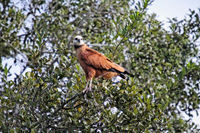Black-Collared Hawk
 From Conservapedia
From Conservapedia | Black-collared Hawk | |
|---|---|

| |
| Scientific classification | |
| Kingdom Information | |
| Domain | Eukaryota |
| Kingdom | Animalia |
| Subkingdom | Bilateria |
| Branch | Deuterostomia |
| Phylum Information | |
| Phylum | Chordata |
| Sub-phylum | Vertebrata |
| Infraphylum | Gnathostomata |
| Class Information | |
| Superclass | Tetrapoda |
| Class | Aves |
| Sub-class | Neornithes |
| Infra-class | Neoaves |
| Order Information | |
| Order | Accipitriformes |
| Sub-order | Accipitres |
| Family Information | |
| Superfamily | Accipitroidea |
| Family | Accipitridae |
| Sub-family | Buteoninae |
| Genus Information | |
| Genus | Busarellus |
| Species Information | |
| Species | B. nigricollis |
| Population statistics | |
| Population | Unknown (2016 est.)[1] |
| Conservation status | Least concern[2] |
The black-collared hawk (Busarellus nigricollis) is a species of bird of prey of the family Accipitridae, and found throughout much of the subtropical and tropical forests and swamps of Central and South America.
Contents
Description[edit]
The black-collared hawk is fairly large, with a body length of 17.9 to 22.8 inches, a wingspan of 45.4 to 56.4 inches, and weigh between 13.8 and 29.2 ounces. On average, females are usually only 6%, but at most up to 15% larger than males. The species is powerfully built with a relatively small head. Adults are predominantly a cinnamon-reddish in color overall, with it slightly lighter in color on the lower belly. Primaries, secondaries, the ends of the upper wing coverts, and the tail are black. In contrast, the the head is a cream to white, and bears a black half ring "collar" on the front of the neck. The iris is reddish brown, the beak blackish gray. Feet and legs are bluish white to pale flesh-colored. Juvenile birds are rather patchy in black above and below, with the leg plumage dark banded and the dark tail band is narrower.
The species is the only one of its kind and differs from other buzzard hawks in bearing thorny soles and toes as well as the strongly bent claws - characteristics which are reminiscent of the osprey. The plumage, however, is not water repellent, so that birds that have dived into the water beyond the legs have to dry themselves for a long time. Sometimes the plumage can become so full of water that the birds have to swim to shore.
Subspecies[edit]
- Busarellus nigricollis leucocephalus; Paraguay, Uruguay and northern Argentina
- Busarellus nigricollis nigricollis; central Mexican lowlands to Amazonian Brazil and eastern Bolivia
Range and habitat[edit]
The black-collared hawk is found in southern Mexico, through Central America, and into large parts of tropical South America east of the Andes. In Mexico, the area extends from southern Veracruz and Campeche to the Yucatán Peninsula and on the Pacific coast from Sinaloa to Chiapas. In Central America, the species occurs in Guatemala, Belize, El Salvador, Honduras, Nicaragua, Costa Rica and Panama. In South America, the western frontier spreads through Colombia and eastern Ecuador, across the eastern part of Peru and Bolivia and northeastern Argentina to northern Uruguay. To the east of this border, the species is only missing in the mountainous region of Guiana and in northwestern Brazil. A scattered population exists on the island of Trinidad.
It is found at or near lowland fresh and brackish water in systems which are shallow, slow-moving, and have pronounced floating leaf vegetation. It takes advantage of a variety of landscape types, ranging from wooded areas to open landscapes, mangrove forests, swamps, rice fields, drainage ditches along roads, along forest streams and ponds, and also on marshy Amazonian islands. In elevation it is usually found from sea level to not more than than 1,500 feet.
Diet[edit]
The black-collared hawk feeds primarily on fish, but occasionally will take frogs, snails or large insects; rarely, small mammals, birds or reptiles are hunted. It hunts from a perch, slipping off for a short flight to grab the prey, which is then carried to a perch up to 900 feet away. According to a short field study, 57% of hunting attempts were successful.
Reproduction[edit]
The breeding season varies with location. In Suriname it is between June and December, in Guyana and Colombia in April, and in Paraguay and northern Argentina from August to September.
The sometimes quite large nests consist of branches and are lined with fresh leaves, and placed high up in large trees, which are often near the water; mangroves are sometimes selected as sites, and they have been known to nest near coffee plantations. Nests are sometimes reused in subsequent years. The clutch consists of 1-2 eggs[3].
Threats[edit]
The black-collared hawk is not threatened, and classified as "least concern" by the ICUN due to its large range[4]. In the northern part of its range it is generally rare, but often quite common in South America in suitable habitats. Regionally, however, it can only appear scattered there, as in southern Brazil, for example. In Central America, the stock is partly declining due to drainage and increasing land use[5].
References[edit]
- ↑ https://www.iucnredlist.org/species/22695842/93529977#population
- ↑ https://www.iucnredlist.org/species/22695842/93529977
- ↑ https://www.researchgate.net/publication/316990917_Black-collared_Hawk_Busarellus_nigricollis_in_French_Guiana_distribution_population_size_and_breeding_biology
- ↑ http://datazone.birdlife.org/species/factsheet/black-collared-hawk-busarellus-nigricollis
- ↑ http://www.neotropicalbirdclub.org/articles/34/Bertassoni.pdf
Categories: [Birds of Prey] [Hawks]
↧ Download as ZWI file | Last modified: 02/06/2023 05:49:36 | 5 views
☰ Source: https://www.conservapedia.com/Black-collared_hawk | License: CC BY-SA 3.0
 ZWI signed:
ZWI signed: KSF
KSF